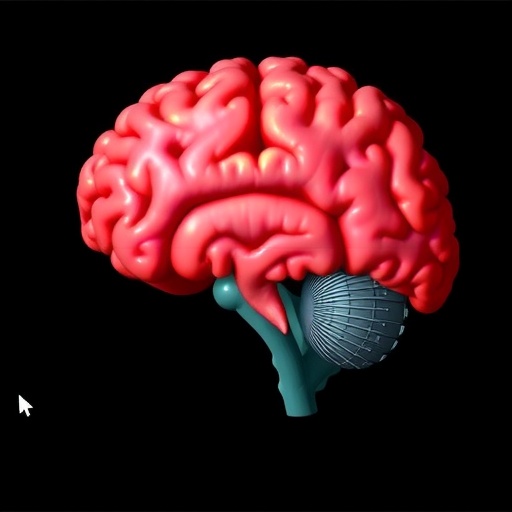In a recent groundbreaking study published in BMC Psychiatry, researchers have harnessed the power of machine learning to delve deeper into the complexities of pediatric bipolar disorder (PBD), particularly distinguishing between cases with and without psychotic symptoms. This pioneering work leverages advanced neuroimaging techniques alongside sophisticated computational models to unravel subtle yet significant brain structure variations that could illuminate new pathways for diagnosis and treatment.
At the core of this investigation lies the thalamus, a critical brain region celebrated for its pivotal role in sensory processing, emotional regulation, and cognitive integration. Known as the brain’s relay center, the thalamus orchestrates the flow of information between various neural circuits. Disruptions within its intricate subregions have long been hypothesized to contribute to psychiatric phenomena, especially psychosis, which manifests as hallucinations, delusions, and impaired reality testing.
To explore this hypothesis, the international research team enrolled a cohort of pediatric individuals diagnosed with bipolar disorder, meticulously categorized into two distinct groups: those exhibiting psychotic symptoms (P-PBD) and those without (NP-PBD). Complementing these clinical groups was a healthy control group matched for age and demographic variables. All participants underwent high-resolution structural magnetic resonance imaging (sMRI) on a 3.0 Tesla scanner, renowned for its precision in capturing neuroanatomical details.
The acquired imaging data underwent rigorous processing using FreeSurfer 7.4.0, a state-of-the-art neuroimaging software that enables automated and reliable segmentation of brain structures. The focus was the volumetric analysis of specific thalamic subregions, a level of granularity essential for uncovering nuanced structural differences that might escape coarser analyses. This methodology allowed the researchers to examine volumetric changes within distinct thalamic nuclei, such as the pulvinar anterior and the reuniens medial ventral regions.
Statistical analyses, including analyses of covariance (ANCOVA), revealed that volumetric differences in two key subregions—the left pulvinar anterior (L_PuA) and the left reuniens medial ventral (L_MV-re)—were significantly different across the three groups. Specifically, children with psychotic PBD showed pronounced volume reductions in these subregions compared to both non-psychotic PBD peers and healthy controls. These findings suggest a potential structural biomarker within these thalamic areas that correlates with the manifestation of psychotic symptoms.
To bolster the clinical relevance of these structural findings, the team implemented a support vector classification (SVC) machine learning model. Support vector machines are powerful algorithms in pattern recognition and classification tasks, particularly adept at handling high-dimensional neuroimaging data. The model performed pairwise comparisons across groups to determine which brain regions most effectively distinguished psychotic cases from others.
The SVC analysis underscored the left reuniens medial ventral thalamic volume as the most discriminative feature, exhibiting superior capacity to classify individuals with psychotic symptoms from those without and from healthy controls. Such a result highlights the promise of combining neuroimaging and artificial intelligence not only to understand psychiatric disorders more deeply but also to pave the way toward objective, brain-based diagnostic criteria.
These insights carry profound implications. Pediatric bipolar disorder, especially with psychotic features, poses significant challenges in early diagnosis, prognostication, and treatment planning. Psychotic symptoms often portend a more severe clinical course, increased morbidity, and therapeutic resistance. Identifying robust neural correlates thus offers the tantalizing prospect of refining diagnostic accuracy and personalizing intervention strategies.
Moreover, this study adds to a growing body of literature emphasizing the thalamus’s integral role in psychiatric illnesses. While traditionally overshadowed by cortical regions in psychiatric research, the thalamus’s functional and structural integrity appears indispensable to maintaining normal emotional and cognitive functioning. Its subregional atrophy may disrupt thalamocortical and limbic circuitries fundamental to mood regulation and perception.
Nevertheless, the investigation is not without limitations. The relatively modest sample size, inherent in many neuroimaging studies involving pediatric populations, calls for validation in larger, multi-site cohorts. Additionally, longitudinal data could elucidate whether these volumetric changes precede psychotic symptom onset or emerge as a consequence. Incorporating multimodal imaging, including functional MRI and diffusion tensor imaging, might further unravel the connectivity alterations accompanying structural deficits.
Looking forward, the fusion of machine learning with neuroimaging heralds a paradigm shift in psychiatric research. By enabling extraction of subtle, multidimensional patterns from complex brain data, such approaches transcend traditional analytic constraints. They hold promise for revolutionizing diagnosis, prognosis, and even unveiling novel therapeutic targets grounded in brain biology.
In essence, this research marks a significant stride in decoding the neural substrates of pediatric bipolar disorder with psychosis. The distinct reductions in the left pulvinar anterior and left reuniens medial ventral thalamic volumes illuminate a path toward objective biomarkers. As computational power and imaging techniques advance, integrating these findings into clinical practice could eventually transform how clinicians identify and manage this debilitating psychiatric condition in youth.
Ultimately, bridging neurobiology and machine learning offers hope not just for better diagnostics, but for fundamentally altering the trajectory of pediatric bipolar disorder, improving outcomes and quality of life for affected children and their families worldwide.
Subject of Research: Structural neuroimaging and machine learning classification of pediatric bipolar disorder with and without psychotic symptoms focusing on thalamic subregional volumes.
Article Title: Machine learning for classification of pediatric bipolar disorder with and without psychotic symptoms based on thalamic subregional structural volume.
Article References:
Gao, W., Zhang, K., Jiao, Q. et al. Machine learning for classification of pediatric bipolar disorder with and without psychotic symptoms based on thalamic subregional structural volume. BMC Psychiatry 25, 574 (2025). https://doi.org/10.1186/s12888-025-07018-5
Image Credits: AI Generated




